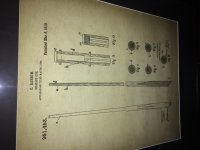First off, I'm not an expert by any means ...and I have not done extensive research but though I'd ask anyway since there's a lot of knowledgeable folks here.
I know that Predator has many patents.
But the key design element, the heart of what has given Predator the advantage in low deflection all these years has been having a bored out shaft at the tip end.
Other manufacturers have come close, but have yet to match or exceed Predator's performance, because no matter what they try, they cannot get lower mass than air. Simple at that. Foam and all this other nonsense...more mass than air.
That said, I Googled some of their patents, and they have several and several of them refer to many of the same design principles. These date from 1994ish onward to 2005.
My understand is that patents of such type are valid from 20 years from the filing date listed on the patent.
Predator also describes much of their research and the results of such research in their patents - particularly that lower mass toward the end of the shaft is beneficial for low deflection, but more specifically - the lower the mass closer to the tip, the greater the improvement in low deflection is. It isn't just about having a low total weight/mass in the first 4-5 inches...it's also about having the lowest possible mass toward the tip. Hence how they bore out the shafts with a wider bore toward the tip, and a smaller diameter bore further down. Obviously, a balance between low mass and durability.
One of their patents expires next month. Others may have already expired. Some will be expiring in the next 18-24 months.
Why do I bring this up? Well first of all, while there's about a dozen low deflection shafts on the market - I'm not sure any of them have a bored shaft that is left empty. Is this true?
I suppose what I'm getting at is -- once other manufacturers can do this, they should all be able to at least meet Predator's low deflection performance. Something they've come close to, but haven't matched. One might think they'll surpass being that they've come close without having to bore the shaft and leave it empty. But the research shows that there's a sort of diminishing returns factor here. An empty shaft is what is needed to get that last bit of low deflection performance after thin/short ferrules, small diameter tips....
Probably makes sense now why Predator released the REVO. It's not like anything in the REVO wasn't thought of more than a decade ago. Or that the technology or materials or manufacturing capability wasn't there. I believe they have a composite shaft patent for that going back a decade.
This is a way for them to change the market attitudes and perceptions toward the next best thing. Just my theory. At some point, everyone else will be able to offer the same, and they need a way to differentiate now.
Time and time again, on this forum and across the web the question is asked "How does _______ compare to the Predator _______"
And the answer is always "It's low deflection but not as low as Predator"
That could change very soon. Would be great to see OB, Mezz, and all the others put out shafts that are as low deflection as the 314 and Z series....they're close now, but not as good.
I know that Predator has many patents.
But the key design element, the heart of what has given Predator the advantage in low deflection all these years has been having a bored out shaft at the tip end.
Other manufacturers have come close, but have yet to match or exceed Predator's performance, because no matter what they try, they cannot get lower mass than air. Simple at that. Foam and all this other nonsense...more mass than air.
That said, I Googled some of their patents, and they have several and several of them refer to many of the same design principles. These date from 1994ish onward to 2005.
My understand is that patents of such type are valid from 20 years from the filing date listed on the patent.
Predator also describes much of their research and the results of such research in their patents - particularly that lower mass toward the end of the shaft is beneficial for low deflection, but more specifically - the lower the mass closer to the tip, the greater the improvement in low deflection is. It isn't just about having a low total weight/mass in the first 4-5 inches...it's also about having the lowest possible mass toward the tip. Hence how they bore out the shafts with a wider bore toward the tip, and a smaller diameter bore further down. Obviously, a balance between low mass and durability.
One of their patents expires next month. Others may have already expired. Some will be expiring in the next 18-24 months.
Why do I bring this up? Well first of all, while there's about a dozen low deflection shafts on the market - I'm not sure any of them have a bored shaft that is left empty. Is this true?
I suppose what I'm getting at is -- once other manufacturers can do this, they should all be able to at least meet Predator's low deflection performance. Something they've come close to, but haven't matched. One might think they'll surpass being that they've come close without having to bore the shaft and leave it empty. But the research shows that there's a sort of diminishing returns factor here. An empty shaft is what is needed to get that last bit of low deflection performance after thin/short ferrules, small diameter tips....
Probably makes sense now why Predator released the REVO. It's not like anything in the REVO wasn't thought of more than a decade ago. Or that the technology or materials or manufacturing capability wasn't there. I believe they have a composite shaft patent for that going back a decade.
This is a way for them to change the market attitudes and perceptions toward the next best thing. Just my theory. At some point, everyone else will be able to offer the same, and they need a way to differentiate now.
Time and time again, on this forum and across the web the question is asked "How does _______ compare to the Predator _______"
And the answer is always "It's low deflection but not as low as Predator"
That could change very soon. Would be great to see OB, Mezz, and all the others put out shafts that are as low deflection as the 314 and Z series....they're close now, but not as good.

